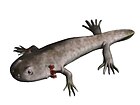셀레노카라
Selenocara| 셀레노카라 시간 범위: 이른 트라이아스기, Olenekian PreꞒ Ꞓ OSDCPTJKPg N↓. | |
|---|---|
| 과학적 분류 | |
| 킹덤: | |
| 망울: | |
| 등급: | |
| 주문: | |
| Suborder: | |
| Superfamily: | |
| 패밀리: | |
| 지누스: | †셀레노카라 , 1997년 Bjerring |
| 이항 이름 | |
| †Selenocara groenlandica Säve-Söderbergh, 1935년 | |
| 다른 종 | |
| |
mastodonsauroid temnospondyl의 Selenocara는 멸종된 유인원 속이다. 그 형식 종은 Selenocara groenlandica, 군나르 Säve-Söderbergh에 의해 1935년 남부 트라이아스기 Wordie 크리크 형성 그린 랜드의 해골 뼈들의 기준에 설명되어. Säve-Söderbergh는 원래 Wetlugasaurus 새로운 종의 묘사했다.[1]
그 최초로 1997년 한스 C에 의해 redescribed다Bjerring는 별도의 종 Selenocara는 Wetlugasaurus groenlandicus 이적했다. Bjerring은 뒤통수 condyles(둘 다 횡단선으로. 가로),orbitofacial가 완전힐 때 배로 볼 때orbitopalatine 통로로, 각orbitofacial 오프닝의 긴 축이 동측의 청각의 벤 상처를 향한 가시적으로 등장 인물들은 justif에 있는 것에 대해 수준은 방형 condyles이 있었다.S.groenlandica의 로사 Wetlugasaurus의 배제 Ying. Bjerring은 제네릭 이름은 그리스의 언어 selene, 즉 달, kara 및 머리에서 유래되었다;그 이름paleontologist Eigil 닐센, 현대 그린 랜드 탐험가들 사이에서 Månen, 달을 덴마크 단어의 별명으로 가 기리는 것이라고 말했다.[2]
다미아니(2001년)Bjerring의 주장과 유개념 Wetlugasaurus는 별개의 것으로서 Selenocara에 대한 찬성에 동의하지 않았다. 저자는 Wetlugasaurus에 groenlandicus은 뒤통수 condyles 분명히 잘 진척된 정방형의 condyles에 놓이고, 다미아니 다른 캐릭터들signifact 분류학적 중요한 것 Bjerring으로 되어 고려하지 않았음을 제시했다. 다미아니는 종들은 로사 Wetlugasaurus으로 Wgroenlandicus를 유지했다.[3]
반면 노비코프(2016년)는 셀레노카라를 Wetlugasaurus와는 구별되는 속성으로 유지했다. 또 저자는 러시아 오렌부르크주와 사마라주의 로시카(Lower Triasis Sukhorecka Formation, Orenburg Orburg Orburg Orburg Orburg Orburg Oriaga) 침전물의 두개골 파편을 근거로 셀레노카라(S. Rossica) 속 2종을 묘사했다.[4]
참조
- ^ Gunnar Säve-Söderbergh (1935). "On the dermal bones of the head in labyrinthodont stegocephalians and primitive Reptilia with special reference to Eotriassic stegocephalians from East Greenland". Meddelelser om Grønland. 98: 1–211.
- ^ Hans C. Bjerring (1997). "The question of the Eotriassic tetrapod genus Wetlugasaurus in Greenland and thoughts on the fossa coniformis entopterygoidea". Meddelelser om Grønland, Geoscience. 34: 1–25.
- ^ Ross J. Damiani (2001). "A systematic revision and phylogenetic analysis of Triassic mastodonsauroids (Temnospondyli: Stereospondyli)". Zoological Journal of the Linnean Society. 133 (4): 379–482. doi:10.1111/j.1096-3642.2001.tb00635.x.
- ^ I. V. Novikov (2016). "New tempospondyl amphibians from the basal Triassic of the Obshchii Syrt Highland, Eastern Europe". Paleontological Journal. 50 (3): 297–310. doi:10.1134/S0031030116030035.
{{cite journal}}: CS1 maint: 작성자 매개변수 사용(링크)

















